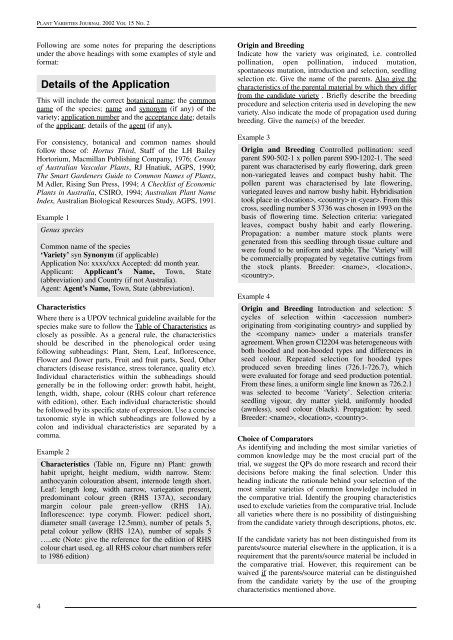44. Volume 15- Number 2 - IP Australia
44. Volume 15- Number 2 - IP Australia
44. Volume 15- Number 2 - IP Australia
You also want an ePaper? Increase the reach of your titles
YUMPU automatically turns print PDFs into web optimized ePapers that Google loves.
PLANT VARIETIES JOURNAL 2002 VOL <strong>15</strong> NO. 2<br />
Following are some notes for preparing the descriptions<br />
under the above headings with some examples of style and<br />
format:<br />
Details of the Application<br />
This will include the correct botanical name; the common<br />
name of the species; name and synonym (if any) of the<br />
variety; application number and the acceptance date; details<br />
of the applicant; details of the agent (if any).<br />
For consistency, botanical and common names should<br />
follow those of: Hortus Third, Staff of the LH Bailey<br />
Hortorium, Macmillan Publishing Company, 1976; Census<br />
of <strong>Australia</strong>n Vascular Plants, RJ Hnatiuk, AGPS, 1990;<br />
The Smart Gardeners Guide to Common Names of Plants,<br />
M Adler, Rising Sun Press, 1994; A Checklist of Economic<br />
Plants in <strong>Australia</strong>, CSIRO, 1994; <strong>Australia</strong>n Plant Name<br />
Index, <strong>Australia</strong>n Biological Resources Study, AGPS, 1991.<br />
Example 1<br />
Genus species<br />
Common name of the species<br />
‘Variety’ syn Synonym (if applicable)<br />
Application No: xxxx/xxx Accepted: dd month year.<br />
Applicant: Applicant’s Name, Town, State<br />
(abbreviation) and Country (if not <strong>Australia</strong>).<br />
Agent: Agent’s Name, Town, State (abbreviation).<br />
Characteristics<br />
Where there is a UPOV technical guideline available for the<br />
species make sure to follow the Table of Characteristics as<br />
closely as possible. As a general rule, the characteristics<br />
should be described in the phenological order using<br />
following subheadings: Plant, Stem, Leaf, Inflorescence,<br />
Flower and flower parts, Fruit and fruit parts, Seed, Other<br />
characters (disease resistance, stress tolerance, quality etc).<br />
Individual characteristics within the subheadings should<br />
generally be in the following order: growth habit, height,<br />
length, width, shape, colour (RHS colour chart reference<br />
with edition), other. Each individual characteristic should<br />
be followed by its specific state of expression. Use a concise<br />
taxonomic style in which subheadings are followed by a<br />
colon and individual characteristics are separated by a<br />
comma.<br />
Example 2<br />
Characteristics (Table nn, Figure nn) Plant: growth<br />
habit upright, height medium, width narrow. Stem:<br />
anthocyanin colouration absent, internode length short.<br />
Leaf: length long, width narrow, variegation present,<br />
predominant colour green (RHS 137A), secondary<br />
margin colour pale green-yellow (RHS 1A).<br />
Inflorescence: type corymb. Flower: pedicel short,<br />
diameter small (average 12.5mm), number of petals 5,<br />
petal colour yellow (RHS 12A), number of sepals 5<br />
…..etc (Note: give the reference for the edition of RHS<br />
colour chart used, eg. all RHS colour chart numbers refer<br />
to 1986 edition)<br />
Origin and Breeding<br />
Indicate how the variety was originated, i.e. controlled<br />
pollination, open pollination, induced mutation,<br />
spontaneous mutation, introduction and selection, seedling<br />
selection etc. Give the name of the parents. Also give the<br />
characteristics of the parental material by which they differ<br />
from the candidate variety . Briefly describe the breeding<br />
procedure and selection criteria used in developing the new<br />
variety. Also indicate the mode of propagation used during<br />
breeding. Give the name(s) of the breeder.<br />
Example 3<br />
Origin and Breeding Controlled pollination: seed<br />
parent S90-502-1 x pollen parent S90-1202-1. The seed<br />
parent was characterised by early flowering, dark green<br />
non-variegated leaves and compact bushy habit. The<br />
pollen parent was characterised by late flowering,<br />
variegated leaves and narrow bushy habit. Hybridisation<br />
took place in , in . From this<br />
cross, seedling number S 3736 was chosen in 1993 on the<br />
basis of flowering time. Selection criteria: variegated<br />
leaves, compact bushy habit and early flowering.<br />
Propagation: a number mature stock plants were<br />
generated from this seedling through tissue culture and<br />
were found to be uniform and stable. The ‘Variety’ will<br />
be commercially propagated by vegetative cuttings from<br />
the stock plants. Breeder: , ,<br />
.<br />
Example 4<br />
Origin and Breeding Introduction and selection: 5<br />
cycles of selection within <br />
originating from and supplied by<br />
the under a materials transfer<br />
agreement. When grown CI2204 was heterogeneous with<br />
both hooded and non-hooded types and differences in<br />
seed colour. Repeated selection for hooded types<br />
produced seven breeding lines (726.1-726.7), which<br />
were evaluated for forage and seed production potential.<br />
From these lines, a uniform single line known as 726.2.1<br />
was selected to become ‘Variety’. Selection criteria:<br />
seedling vigour, dry matter yield, uniformly hooded<br />
(awnless), seed colour (black). Propagation: by seed.<br />
Breeder: , , .<br />
Choice of Comparators<br />
As identifying and including the most similar varieties of<br />
common knowledge may be the most crucial part of the<br />
trial, we suggest the QPs do more research and record their<br />
decisions before making the final selection. Under this<br />
heading indicate the rationale behind your selection of the<br />
most similar varieties of common knowledge included in<br />
the comparative trial. Identify the grouping characteristics<br />
used to exclude varieties from the comparative trial. Include<br />
all varieties where there is no possibility of distinguishing<br />
from the candidate variety through descriptions, photos, etc.<br />
If the candidate variety has not been distinguished from its<br />
parents/source material elsewhere in the application, it is a<br />
requirement that the parents/source material be included in<br />
the comparative trial. However, this requirement can be<br />
waived if the parents/source material can be distinguished<br />
from the candidate variety by the use of the grouping<br />
characteristics mentioned above.<br />
4

















